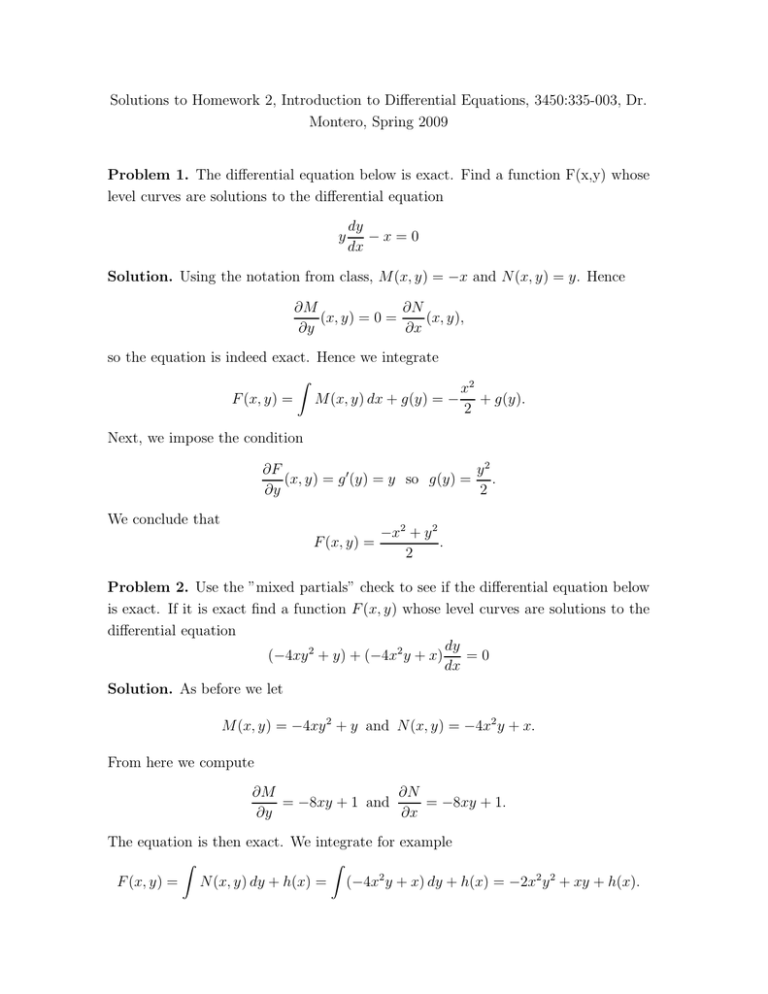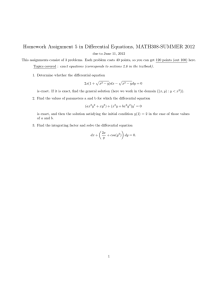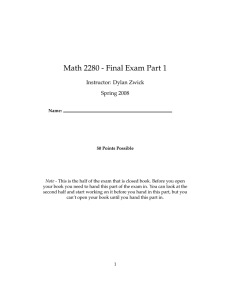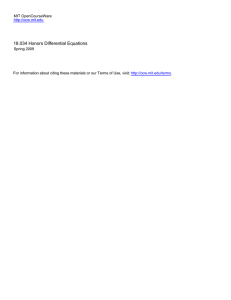Solutions to Homework 2, Introduction to Differential Equations
advertisement

Solutions to Homework 2, Introduction to Differential Equations, 3450:335-003, Dr. Montero, Spring 2009 Problem 1. The differential equation below is exact. Find a function F(x,y) whose level curves are solutions to the differential equation y dy −x=0 dx Solution. Using the notation from class, M(x, y) = −x and N(x, y) = y. Hence ∂N ∂M (x, y) = 0 = (x, y), ∂y ∂x so the equation is indeed exact. Hence we integrate Z x2 F (x, y) = M(x, y) dx + g(y) = − + g(y). 2 Next, we impose the condition y2 ∂F (x, y) = g ′(y) = y so g(y) = . ∂y 2 We conclude that −x2 + y 2 . F (x, y) = 2 Problem 2. Use the ”mixed partials” check to see if the differential equation below is exact. If it is exact find a function F (x, y) whose level curves are solutions to the differential equation dy (−4xy 2 + y) + (−4x2 y + x) =0 dx Solution. As before we let M(x, y) = −4xy 2 + y and N(x, y) = −4x2 y + x. From here we compute ∂M ∂N = −8xy + 1 and = −8xy + 1. ∂y ∂x The equation is then exact. We integrate for example Z Z F (x, y) = N(x, y) dy + h(x) = (−4x2 y + x) dy + h(x) = −2x2 y 2 + xy + h(x). Next we use the condition ∂F ∂x = M(x, y) to obtain ∂F = −4xy 2 + y + h′ (x) = M(x, y) = −4xy 2 + y. ∂x This says h′ (x) = 0 so we take h(x) = 0. Our solution is F (x, y) = −2x2 y 2 + xy. Problem 3. Use the ”mixed partials” check to see if the differential equation below is exact. If it is exact find a function F (x, y) whose level curves are solutions to the differential equation (4ex sin(y) − 3y) + (−3x + 4ex cos(y)) dy = 0. dx Solution. Again, we set M(x, y) = 4ex sin(y) − 3y and N(x, y) = −3x + 4ex cos(y), and compute ∂M ∂N = 4ex cos(y) − 3 and = −3 + 4ex cos(y). ∂y ∂x The equation is exact. Then we integrate for example Z Z F (x, y) = N(x, y) dy+h(x) = (−3x+4ex cos(y)) dy+h(x) = −3xy+4ex sin(y)+h(x). The next step is to use the condition ∂F ∂x = M. This means −3y + 4ex sin(y) + h′ (x) = 4ex sin(y) − 3y. Again we obtain h′ (x) = 0 so h(x) = 0. Our solution is F (x, y) = −3xy + 4ex sin(y). Problem 4. Check that the equation x2 y 3 + x(1 + y 2)y ′ = 0. is not exact but becomes exact when multiplied by the integrating factor µ(x, y) = 1/(xy 3). Solve the differential equation. Solution. We let M(x, y) = x2 y 3 and N(x, y) = x(1 + y 2 ). We compute ∂M ∂N = 3x2 y 2 and = 1 + y 2. ∂y ∂x The equation is not exact. If we now multiply the equation by µ(x, y) = equation becomes 1 1 dy x+ + = 0. y 3 y dx 1 , xy 3 the We redefine M and N as follows: M(x, y) = x and N(x, y) = 1 1 + . y3 y This means ∂M ∂N = 0 and = 0, ∂y ∂x so the equation is now exact. We integrate for instance Z Z 1 1 1 dy + h(x) = − 2 + ln(y) + h(x). + F (x, y) = N(x, y) dy + h(x) = 3 y y 2y The condition ∂F ∂x = M says h′ (x) = x so h(x) = F (x, y) = − x2 . 2 This means that our solution is x2 1 + ln(y) + . 2y 2 2 Problem 5. Find an explicit or implicit solutions to the differential equation (x2 − 3xy) + x dy = 0. dx Hint: Try to find an integrating factor that depends only on one variable. Solution. We let M(x, y) = x2 − 3xy and N(x, y) = x. We compute ∂M ∂N = −3x and = 1. ∂y ∂x The equation is not exact. We seek an integrating factor that depends on one variable only. Let us recall that this is possible if either ∂M ∂y − N ∂N ∂x is independent of y or ∂N ∂x − M ∂M ∂y is independent of x. Here ∂M ∂y − N ∂N ∂x = −3x − 1 x is independent of y, so we solve 1 dµ −3x − 1 = . µ dx x This is a separable equation. We integrate directly to obtain ln(µ) = −3x − ln(x), so e−3x . x We multiply the equation by this integrating factor to obtain the new equation µ(x) = e−3x (x − 3y) + e−3x dy = 0. dx We redefine M, N: M(x, y) = e−3x (x − 3y) so ∂M = −3e−3x , ∂y and ∂N = −3e−3x . ∂x The equation is now exact. We integrate for instance Z Z F (x, y) = M(x, y) dx + g(y) = e−3x (x − 3y) dx + g(y). N(x, y) = e−3x so We need the integral Z xe−3x dx which we integrate by parts with u = x and dv = e−3x : Z Z xe−3x 1 xe−3x 1 −3x −3x xe dx = − e−3x dx = − + − e . 3 3 3 9 So far we have xe−3x 1 −3x − e + ye−3x + g(y). 3 9 = N to obtain F (x, y) = − Next we use the condition ∂F ∂y e−3x + g ′ (y) = e−3x . We conclude that g ′ (y) = 0 so we take g(y) = 0. The solution we seek is F (x, y) = − xe−3x 1 −3x − e + ye−3x . 3 9




